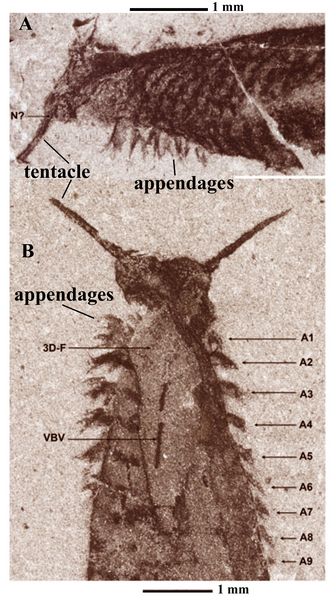Athena Review Image Archive ™
Pikaia gracilens, detail of appendages and tentacles

Detail of body appendages in Pikaia gracilens (after Conway Morris and Caron 2012, pl.11a+c).
Pikaia gracilens was the first known fossil notochord, found in the Burgess Shale in British Columbia (Walcott 1911), dating from the Middle Cambrian period at 520 mya. The genus name Pikaia derives from Pika Peak, a mountain in Alberta, Canada, and the species name gracilens for its slender or gracile form. It belongs to the phylum Chordata, and the subphylum Cephalacordata.
Simon Conway Morris (1979) identified Pikaia as an early fish-like chordate. The average body length of P. gracilens is 3.8 cm. It has a thin, flattened body with a notochord and regular segmentation, composed of paired muscle segments or myomeres. It lacked lateral fins, but had a dorsal fin, enabling it to swim in S-shaped movements, like an eel.
Its head has a pair of antenna-like tentacles. A series of short appendages, which may be linked to gill slits, are on either side of its head. These are inducated in both figures, labelled A1-A9 in fig.B.
References:
Conway Morris 1979
Conway Morris and Caron 2012
Walcott 1911
Copyright © 1996-2020 Rust Family Foundation (All Rights Reserved).